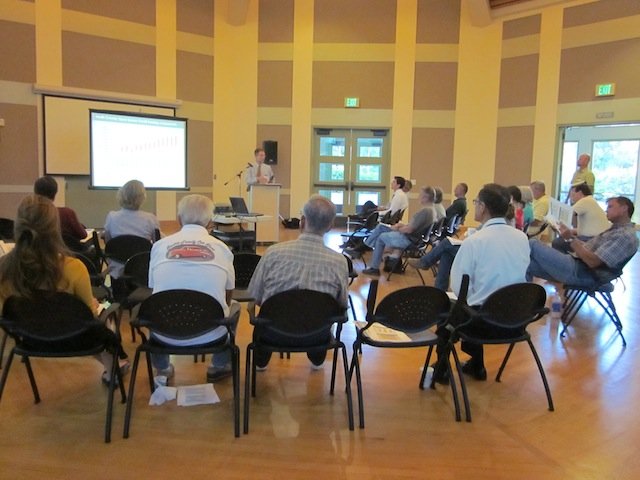
Agricultural water charges in South Santa Clara County are one-tenth of what everyone else pays, thanks to the Open Space Credit Policy implemented in 1991 – and farmers say they want it to stay that way.
But for the last several months, the credit – which allows agriculture users to pay $286.70 less per acre foot than municipal and industrial users in South County – has been under scrutiny.
The Open Space Credit is currently funded by a one percent property tax. Agricultural water rates are $18.30 per acre foot, while municipal and industrial water rates are $305 per acre foot in South County and $680 per acre foot in North County.
Since June, however, the Santa Clara Valley Water District Board of Directors has called the policy into question during a series of agricultural and environmental advisory committee meetings to determine whether the money should be redirected to other community needs, such as unfunded flood protection projects.
The SCVWD held a community stakeholder meeting Monday night at the Morgan Hill Community and Cultural Center to gather public input and feedback on possible policy changes. Following a series of meetings held this summer by a working group consisting of seven representatives from the agricultural, water, land planning and business communities, some say the money should be used for other important projects, while many farmers vehemently protest policy alterations that could significantly affect their livelihood.
“Farmers want to keep rates low,” said Executive Director Jennifer Scheer with the Santa Clara County Farm Bureau. “This is my livelihood and the livelihood for farmers, so this impacts us greatly.”
The SCVWD does not have an estimate of what the potential cost increase to farmers would be if the policy changes, but SCVWD Senior Project Manager Darin Taylor said re-directing the property taxes to other district activities would likely result in an increase in groundwater agricultural charges. It is unclear if increasing the charges would affect the viability of the agricultural lands, he added.
A final decision on the issue will be made during a Nov. 12 SCVWD board meeting. However things pan out, District 1 Director and former mayor of Morgan Hill Dennis Kennedy reiterated that “community outreach is very important to making the best decision.”
According to Kennedy, there is no preconceived plan for how much money would be taken away from the current policy if changes are approved.
“The goal is to find out what the community wants in the big picture and a recommendation will be made depending upon the board’s final decision,” Kennedy said.
So far, the working group has explored the impacts of the current policy as well as what could happen if changes are made to it. Scheer, who is in the group, observed that some members “feel that maybe the money could be better spent or go towards other agricultural and environmental projects.”
Historically, the SCVWD has recognized that agriculture brings value to all residents of Santa Clara County in the form of open space, according to Scheer. During Monday’s meeting, SCVWD staffers showed no signs of which way they are leaning on the issue.
“I haven’t really seen any indication yet of the board’s decision. I still have not made my final decision, but I admit I do have a bias towards agriculture,” Kennedy said. “The policy has served an excellent purpose in helping the sensitive industry of agriculture.”
He described agriculture as an industry with “thin margins” since farmers deal with natural wild cards such as weather, diseases and more.
Approximately 25 people from the agricultural community sat in the audience Monday evening as several SCVWD staff members presented statistical and financial information. Taylor showed a study which quantified the value of open space created by agricultural lands in Santa Clara County.
For example: The value of an average home within 0.25 percent of aesthetic open spaces such as cropland or rangeland increases by 2.2 or 2.56 percent. A home’s value decreases, however, the closer it is to an intensive agriculture operation (for example, one that emits unpleasant odors). The value of an average home within 0.33 miles of intensive agriculture decreases by 6.4 percent, according to Taylor.
He also noted: the Open Space Credit applies only to agricultural water, which is defined as water used for production for the purpose of selling a product to the market.
Looking at the issue from both sides of the argument, Taylor pointed out that if agricultural water rates were increased, the money could be redirected to unfunded flood protection projects.
“In South County there is flood damage on upper Llagas and lower Llagas that have funding shortfalls,” Taylor said.
Farmers in the audience appeared displeased with this proposed redirection of money, including a Palo Alto farmer who claimed that funding for flood protection is a city matter and not an agricultural project.
“I have a vineyard and winery in addition to my farmland and I am loosing sleep over this matter,” the farmer from Palo Alto said.
During a heated debate that ensued during the question and answer portion of the meeting, local farmers were clearly unhappy with any possible policy changes.
The SCVWD board is expected to consider collective feed back from community stakeholders, a full economist’s report and a recommendation from SCVWD staff at a board meeting scheduled for Sept. 24. Final action will be taken at a Nov. 12 board meeting.













